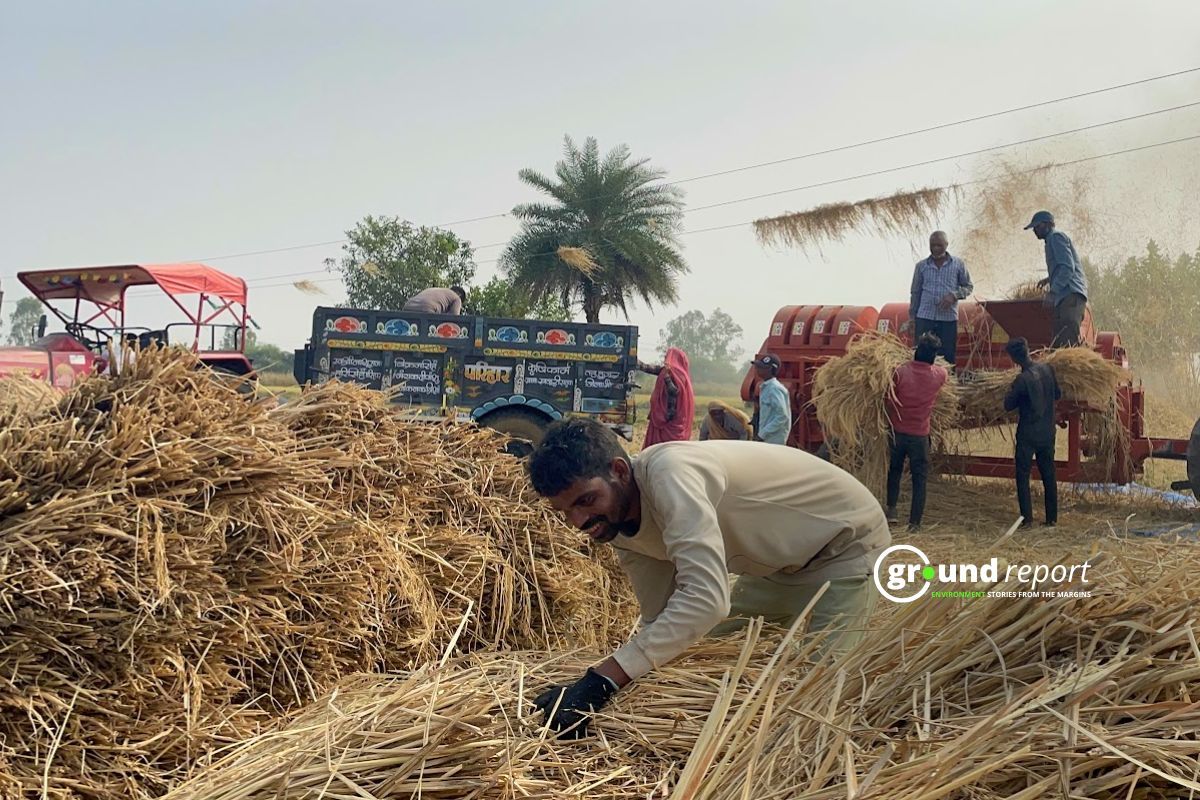“We arrive here at nine in the morning and return home by eight at night. This isn’t our land; we’re just here to work,” says Kamala, a farm labourer from Mungaoli village, 25 km from Sehore town in Madhya Pradesh. Draped in a saffron sari, she methodically cuts paddy plants with a sickle, her hands moving with practiced precision. “We’ll earn ₹250 for today’s work. Last year, it was Rs 200, but this year, it has increased by ₹50.”
Next to Kamala, another farm labourer, Bhuri, is busy harvesting paddy. Her life is equally challenging as she juggles work and childcare. She has brought her two young children to the field.

“My children are small; there’s no one to look after them at home, so I bring them along,” she says.
Bhuri explains her expertise in harvesting paddy, collecting crops, and weeding fields. “But now machines handle most of this work. We only get jobs for short periods, and wages are limited. Any extra help we can get is always welcome,” she adds, reflecting on the changing dynamics of farm labour.
Kamala and Bhuri’s day begins well before sunrise. They finish their household chores before heading out to the fields for a long day of labour. After toiling in the fields until sunset, they return home to resume their responsibilities, preparing meals and tending to their families late into the evening. Their lives reflect an unrelenting rhythm of work, both on the farm and at home, shaped by necessity and resilience.
The lives of women agricultural workers in Madhya Pradesh paint a stark picture of labour inequity, domestic violence, and economic vulnerability. Kamala and Bhuri, labourers harvesting paddy in the villages of the state, exemplify the relentless struggle of women juggling household chores and backbreaking fieldwork for meagre wages. With rising mechanisation, declining employment opportunities under MGNREGA (Mahatma Gandhi National Rural Employment Guarantee Act), and pervasive gender pay gaps, these women find themselves trapped in cycles of poverty and exploitation.
According to a 2023 statement by then-Minister of State for Labour Rameshwar Teli in the Lok Sabha, agriculture remains the largest source of employment for women in India. This assertion, based on the Annual Periodic Labour Force Participation Report (2021-22), highlights that 62% of women find their livelihood in agriculture. However, this statistical generalisation contrasts sharply with the ground realities, where women labourers face systemic challenges, including low wages, limited work days due to mechanisation, and socio-economic vulnerabilities. These issues point to deeper inequities not fully captured in official employment figures.
Sanjay Patidar, whose fields Kamala and Bhuri are working in, says,
“Women do a better job at harvesting crops than men. They are much more hardworking. Men mostly leave for the cities to work as labourers, so women labourers are more readily available.”
In Khajuri Sadak village, located 20 km from Bhopal, many women are seen harvesting paddy in the fields. These women are earning ₹300 per day, which is ₹50 more than what the labourers in the Sehore villages are paid.
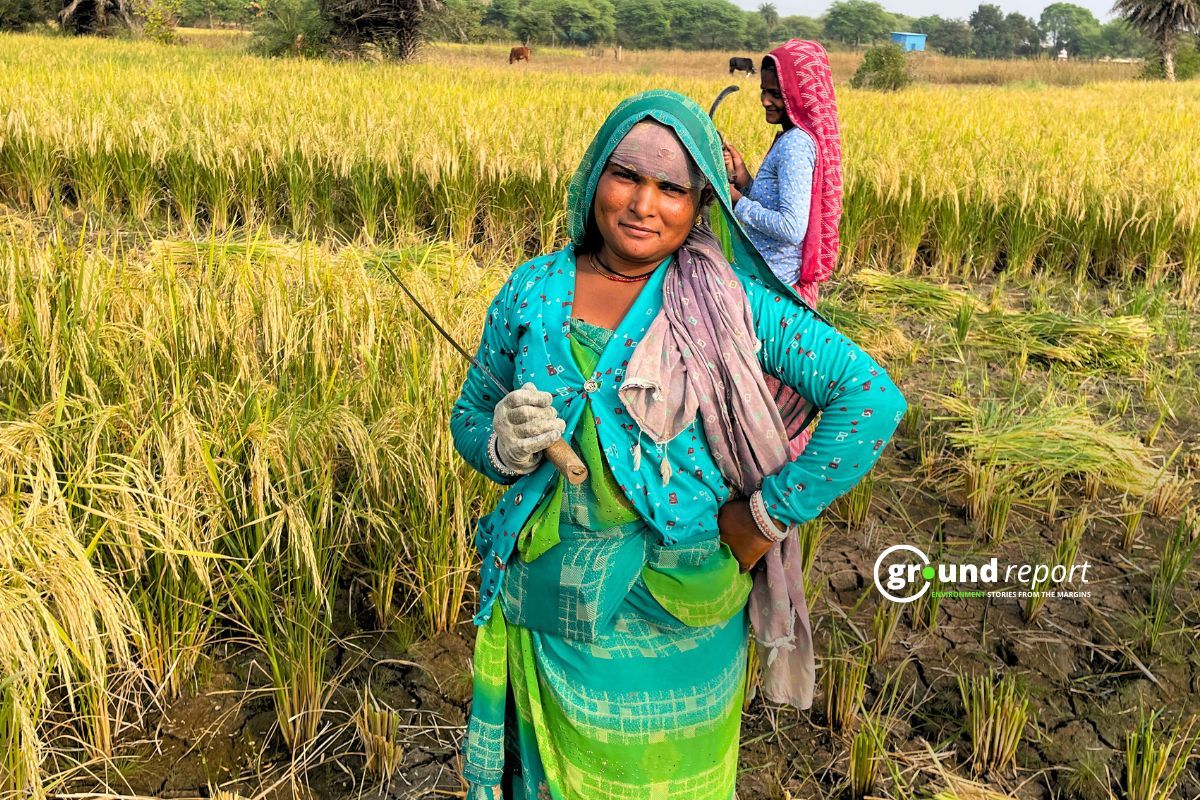
One of them is Maya Prabhu, who has come from Khori village, seven kilometres away, to harvest paddy, describing her daily routine:
“Our entire day is spent working. We wake up in the morning, finish household chores, come here to work in the fields, and return home in the evening to continue working. We just keep working all day long.”
When asked when she is not working, Maya simply replies, “At night, when we sleep.”
Feminist activist Sejal Dand, who works with the organisation Makam (Mahila Kisan Adhikar Manch), attributes the irregular working hours of women like Maya to the weakening of the MGNREGA framework.
Dand explains that most women working in rural fields come from the Bahujan Samaj, and MGNREGA had once provided an alternative source of employment for them. “Through this program, women could find work in their own villages and benefit from the infrastructure they helped build, such as roads and ponds,” she adds.
However, the continuous reduction in MGNREGA’s budget and the weakening of its institutional structure have diminished women’s bargaining power. As a result, they are left with low-wage labour and find themselves trapped in a feudal system, Dand shares.
Over the past decade, Madhya Pradesh has seen a major decline in participation, performance, and budget allocation in MGNREGA (Mahatma Gandhi National Rural Employment Guarantee Act). For example, between the financial years 2021-22 and 2022-23, the number of households participating declined from 6.18 crore to 5.38 crore.
At the same time, the number of man days created under MGNREGA in 2019-20 used to be 265, which also saw a slight jump in the Covid years, but by 2022-23, this graph has fallen to 248 person days. These figures show a major decline in employment generated under MGNREGA.
If viewed from the perspective of budget allocation, it was reduced to 14% in 2022–23, followed by a further decline to 15% in 2023–24. Subsequently, a significant reduction in wage amounts has been recorded. However, the total wages paid in 2023–24 were 40% less than the previous year.
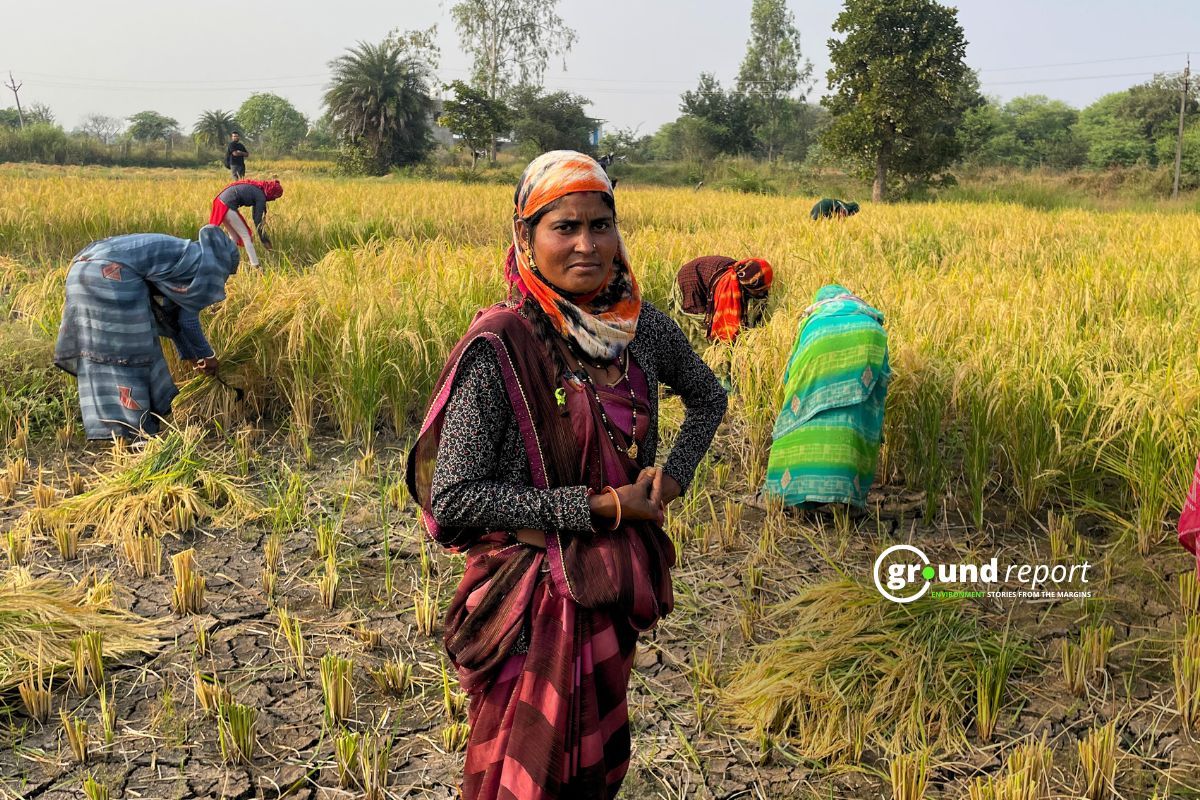
Maya Lakshman, who is currently harvesting paddy in the fields, says she earns Rs 300 a day. She has two children, a boy and a girl, both enrolled in government schools. Maya explains that while they manage to get by, any unexpected expenses, such as a child’s illness or an emergency, force them to take loans. “Without that, it becomes impossible to manage,” she adds. She hopes that wages, which currently barely cover her family’s needs, will increase.
The average daily wage for agricultural labourers in India increased from₹292.05 in 2019-20 to ₹328.18 in 2021-22. State-wise data reveals variation, with Kerala having the highest wages, while Madhya Pradesh had the lowest.
Along with this figure, it can also be seen that there has been a marginal increase of Rs 10 and Rs 4 in daily wages over the year. However, these figures of the government are based on a very small sample, and they are able to present a normal picture, while the situation on the ground is different from these figures.
Dand critiques the increasing mechanisation of agriculture, highlighting how it reduces the working days of women labourers, intensifying their financial strain. She also points out that these women are often labelled “unskilled” by the government, despite the skill required for tasks like paddy harvesting. Additionally, the growing use of chemicals in farming exposes labourers to health risks, yet they often lack protective gear like gloves or masks.
Patriarchy with low wages
A recent report reveals a significant wage gap between male and female rural workers. Men earn Rs 408 daily, while women earn only Rs 281. Despite similar working hours, women also take on household responsibilities after fieldwork. Manoj Nayak, a male labourer, shares that while he earns Rs 400-450, he believes the daily wage should be at least Rs 600 for men and Rs 450 for women.
When asked about the wage disparity, Nayak’s response was met with a satirical remark from a female labourer nearby, who pointed out that the extra money likely goes toward male workers’ alcohol consumption.
Alcoholism and domestic violence
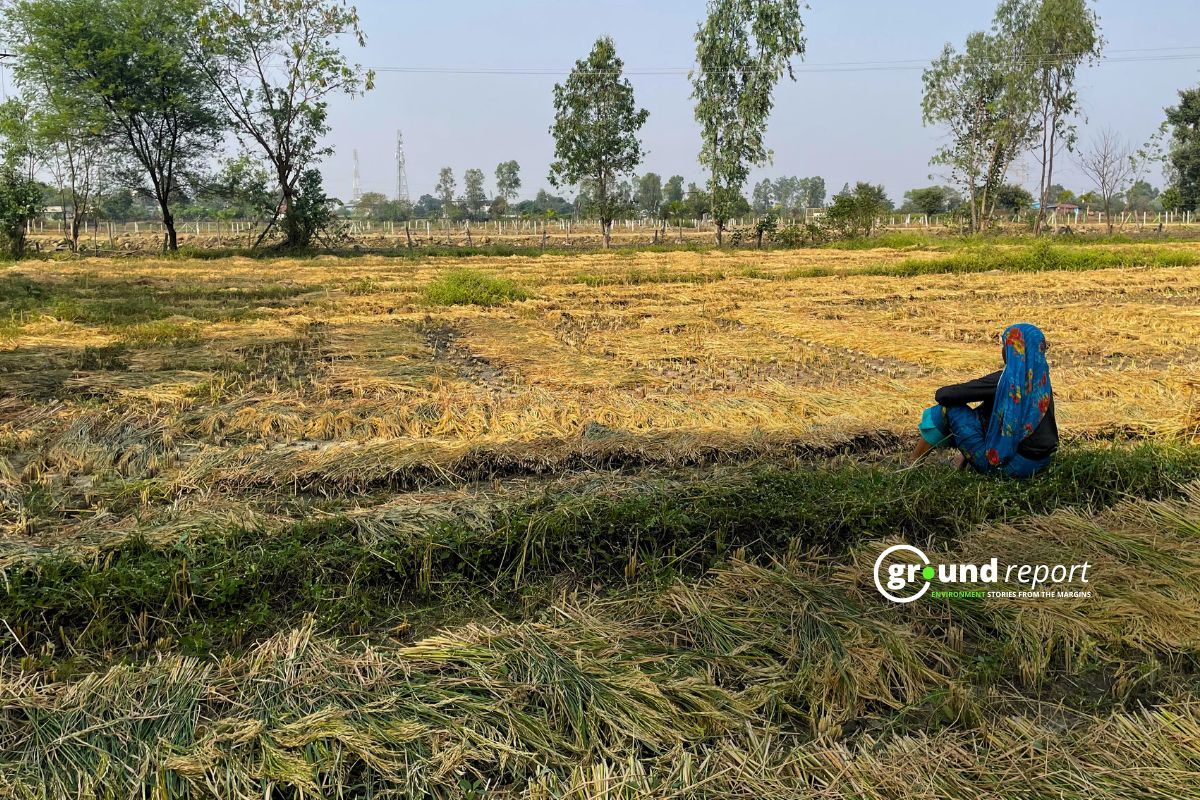
International organisation Oxfam has said in a report that women agricultural workers in India have a high probability of facing domestic violence. Studies in this report show that about 40 percent of women experience domestic violence. More than 97 percent of women working in agriculture in India are in informal employment, which faces a lack of legal protection against violence.
The Oxfam report highlights that women in rural areas are 20% more likely to experience domestic violence if their husbands consume alcohol or have a history of violence. In Khajuri Sadak village, many women working in the fields reported that their husbands often return drunk and subject them to abuse. When asked why they endure such low wages and hard work, one female labourer responds,
“If we don’t work, our husbands will drink and beat us.”
Sejal Dand highlights that women agricultural labourers experience physical, mental, and economic violence, which often goes unreported due to social structures and limited empowerment. Many women in Khajuri Sadak village reported their husbands’ alcohol abuse, which leads to domestic violence, disrupting family life and finances. They expressed a desire for the liquor shop in their village to be shut down to reduce this problem.
Limited data and coverage
In the Government of India’s surveys, data on female workers is only available for those aged 15–59, but in the fields, women and girls outside this age group are also working. The Ground Report Team met 14-year-old Payal, who has been working in the fields for the past two years. Although enrolled in school, Payal must work to earn money as her father is absent. This highlights the need for better representation of young girls like her in labour statistics.
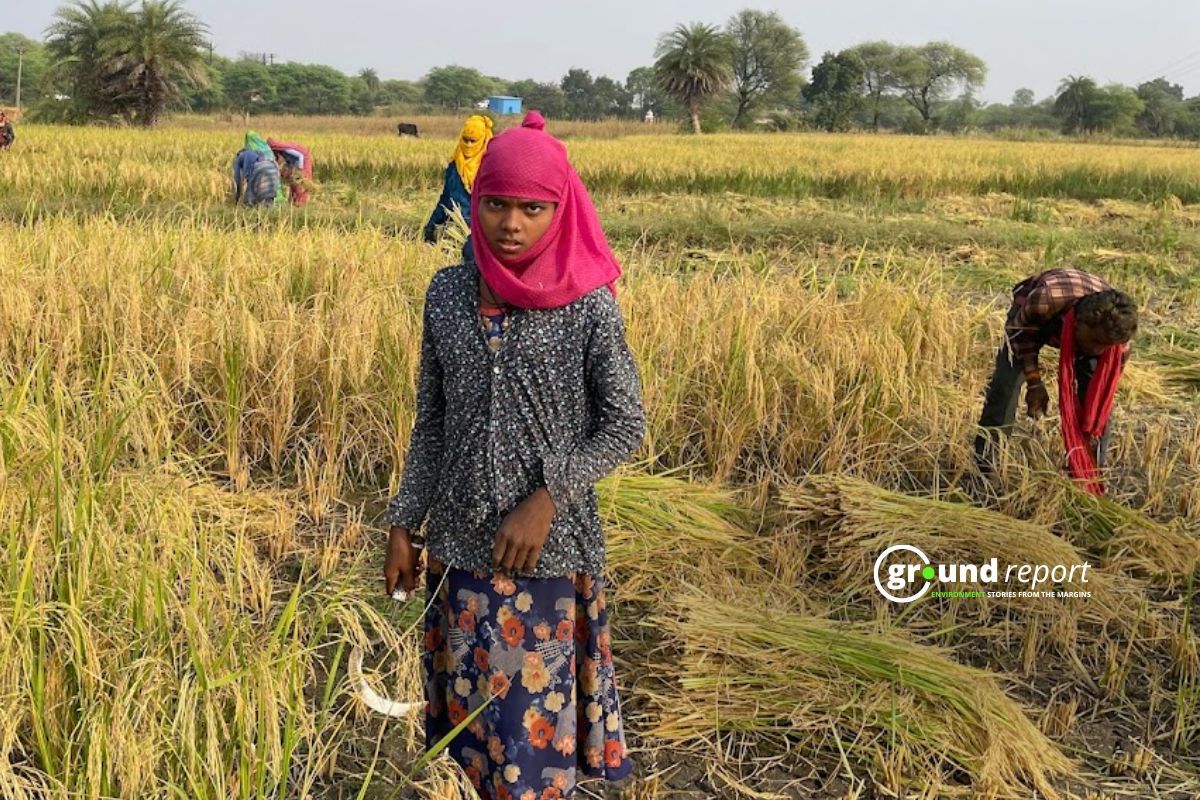
14-year-old Payal, harvesting paddy far from her classroom
A common definition of employment is that it should meet the worker’s essential needs. However, women like Maya, Lalita, Kamala, and Bhuri, who harvest paddy in Khajuri and Mungaoli villages, struggle to support their households despite working all day. Similarly, Payal, who should be attending school, is working in the fields instead. This raises the question: Are many girls like Payal trapped in a cycle of underemployment because they are out of school? This issue challenges the statistics showing 63% of women in agriculture.
Support us to keep independent environmental journalism alive in India.
Keep Reading
Heatwave takes a toll on women agricultural labourers in MP
‘I need blood for bloodline,’ silent struggles of anemia in pregnant women
Paddy farmers struggle with low basmati prices in Madhya Pradesh
Fertilizer shortage disrupts rabi sowing for Madhya Pradesh farmers
Follow Ground Report on X, Instagram and Facebook for environmental and underreported stories from the margins. Give us feedback on our email id greport2018@gmail.com.
Don’t forget to Subscribe to our weekly newsletter, Join our community on WhatsApp, and Follow our YouTube Channel for video stories.


